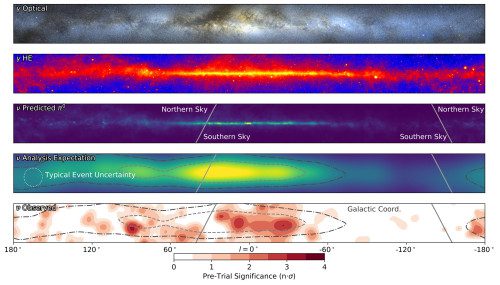29 Jun IceCube shows Milky Way galaxy is a neutrino desert

A multi-messenger view of the Milky Way galaxy, centered on the galactic center and viewed in galactic coordinates. Each panel shows the entire Galactic plane in a band of ±15◦ in galactic latitude, with each panel having a unique color scale. The panels, from top to bottom, are: 1) view in the optical range, which is partly obscured by clouds of gas and dust that absorb optical photons, 2) the integrated flux in gamma rays as seen by the Fermi-LAT 12 year survey, 3) emission template for the expected neutrino flux, taken to match the template from Fermi-LAT measurements, 4) emission template from panel 3 convolved with the IceCube detector acceptance for cascade-like neutrino events and 5) pre-trial significance of the all-sky scan for point-like sources using the cascade neutrino event sample in the same band of the Galactic plane.
The Milky Way galaxy is an awe-inspiring feature of the night sky, dominating all wavelengths of light and viewable with the naked eye as a hazy band of stars stretching from horizon to horizon. Now, for the first time, the IceCube Neutrino Observatory has produced an image of the Milky Way using neutrinos — tiny, ghostlike astronomical messengers.
In a June 30 article in the journal Science, the IceCube Collaboration — an international group of more than 350 scientists — presents this new evidence of high-energy neutrino emission from the Milky Way. The findings indicate that the Milky Way produces far fewer neutrinos than the average distant galaxies.
“What’s intriguing is that, unlike the case for light of any wavelength, in neutrinos, the universe outshines the nearby sources in our own galaxy,” says Francis Halzen, a professor of physics at the University of Wisconsin–Madison and principal investigator at IceCube.
The IceCube search focused on the southern sky, where the bulk of neutrino emission from the galactic plane is expected near the center of the galaxy. However, until now, a background of neutrinos and other particles produced by cosmic-ray interactions with the Earth’s atmosphere made it difficult to parse out neutrinos originating from galactic sources — a significant challenge compounded by relatively sparse neutrino production in general.



